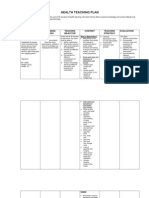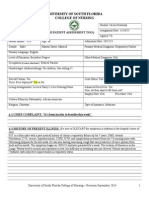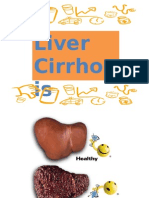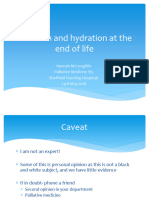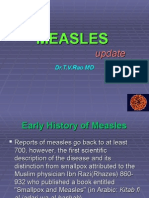Nursing Assessment Form
Nursing Assessment Form
Uploaded by
Maila Carl M. MorantteCopyright:
Available Formats
Nursing Assessment Form
Nursing Assessment Form
Uploaded by
Maila Carl M. MorantteCopyright
Available Formats
Share this document
Did you find this document useful?
Is this content inappropriate?
Copyright:
Available Formats
Nursing Assessment Form
Nursing Assessment Form
Uploaded by
Maila Carl M. MorantteCopyright:
Available Formats
NURSING ASSESSMENT FORM Student: Patient: Maila Carl M.
Morantte GV Age: 78 Marital Status: Widow Date: 22 October 2011 Admission Date: 17/10/2011
Reason for Admission: Shortness of Breath (SOB) upon minimal exertion, Severe Sinus Bradycardia with HR of 26 beats per minute (bpm) Current Medical Diagnosis: Paroxysmal Atrial Fibrillation (PAF), Chronic Heart Failure (CHF), Type II Diabetes Mellitus(DM), Transient Ischemic Attack (TIA), Hypertension (HTN), Chronic Renal Failure (CRF), depression, gout, osteoarthritis (OA) Bradycardia probably from overdose of Amiodarone Surgical Procedure and Date Fracture (#) Neck of Femur (NOF)Right on 05/06/2011 Left femoral embolectomy on 02/07/2011 Past Medical History Three months prior to admission, patient had a hip replacement surgery and had a degree of cardiac failure during the operation. Subsequently the patient was prescribed with Amiodarone 200 mg daily, Digoxin 62.5 micrograms daily, and Metoprolol 95 mg daily. On the 13th of September, a chest x-ray showed increasing congestive heart failure with a large heart shadow. Four days prior to admission patient went to a specialist physician for follow-up and complained of SOB. Electrocardiogram (ECG) was done and showed a sinus rhythm of 26 bpm indicating sever sinus bradycardia. Blood pressure was also 180/40 mm Hg at that time. Patient was then instructed to stop taking Digoxin, Metorprolol, and Amiodarone. During that time patient also agreed to come to Oamaru Hospital on Monday, 17th of October 2011 for further management.
Allergies: None known. FUNCTIONAL HEALTH PATTERNS or NURSING DIAGNOSIS (using NANDA format) 1. Health Perception / Health Maintenance Pattern Patients perception of past general health Patient verbalized, My health before was pretty good, I had no problems at all. Although, yes I had already Type II Diabetes, my life was still normal Patients perception of current health status My health is not really very great nowadays. It is really awful when you feel crook. This time you are not able to do the normal stuff that you usually do. I feel helpless, the patient verbalized. Health management/ practices Eating proper food The patient verbalized, I cant exercise because I cant do anything anymore nowadays. Someone even comes here every week just to help me shower. Taking the medicines Although, I think the doctor said that I must have overmedicated some stuff thats why he told me stop taking those, so I did., the patient said. Ability / willingness to participate in care / compliance with prescribed medicines/ treatment: The patient verbalized willingness to participate in care and treatment. The patient also takes the prescribed medicines. Nursing Needs Therapeutic communication to encourage client towards health improvement Health Education on Proper Nutrition, ROM Exercises (may coordinate with physiotherapist), and proper treatment regimen Encouragement towards smoking cessation treatment Health Education on the adequate amount of alcohol taken each day Possible Nursing Diagnoses Powerlessness (low) related to inability to perform activities of daily living as evidenced by verbal expressions of frustration. Readiness for enhanced therapeutic regimen management as evidenced by an expressed desire to participate in care and treatment. Noncompliance to treatment in reducing risk factors contributing to illness as evidenced by declining smoking cessation treatment
Smoking / Tobacco / Alcohol / Drug History Smokes 4 sticks a day - Declined smoking cessation treatment Drinks 3 shots of Gin a day
Didnt take any illicit drugs
2. Nutritional / Metabolic Pattern Diet Type: Diabetic Diet BGL: 5.3 mmol Appetite: Average % of food eaten at mealtime: 75% Mini nutritional assessment for older adults: Fluid intake in 24 hours: 6 glasses of water or approximately 1.5L (oral) Nausea: None Vomiting: None Weight: 59.7 kg Food Intolerance: Hard Foods (e.g. toasted hard bread) Dentures: Upper set of teeth Oral Cavity Assessment: No pain in the mouth or gums reported. No lesions, cracking, ulcers, swelling, discoloration and redness noted No coating on tongue noted. Gag reflex is intact. Gingiva is pink in color, no edema, bleeding, exudates, and hypertrophy noted. Halitosis not noted. Lower teeth is natural. Skin Integrity: Dryness noted Bilateral edema (grade 2) on lower extremities noted.
Nursing Needs Regular Monitoring of BGL Health Education on Diet referral to dietician Inform kitchen regarding food preparation soft foods must be available for the client Daily Weighing Encourage frequent position changes Possible Nursing Diagnoses Potential for Altered Body Temperature related to aging as evidenced by frequent complaints of being cold. Fluid Volume Excess related to compromised function of the kidneys as evidenced by bilateral edema on the lower extremities. Imbalanced Nutrition: Less than body requirements related to perceived inability to ingest food due to the presence of dentures as evidenced by a steady decrease in weight. Risk for Impaired Skin Integrity related to altered fluid status as evidenced by presence of edema.
Pressure Sore Risk Score (Braden): 20 Pressure Prevention Strategies: Encourage frequent position change Keep the skin dry Encourage adequate intake of fluids and proper diet
3. Elimination Pattern Bowel Pattern (Usual): Everyday in the morning Constipation: None Diarrhea: None, but stools are usually very soft Stool Type: Type 4 in the Bristol Scale Elimination Aids: Loperamide Ostomy: None Abdomen: soft, generally distended Bowel Sounds: 5-20 bowel sounds per minute Bladder: has urge incontinence usually at night Urine Output in 24 hours: 5 times, approximately 1,200mL Urine: clear and pale yellow in color Catheter: None
Nursing Needs: Record incontinence time Schedule voiding 30 minutes before incontinence times Schedule fluid intake Health education on exercises to strengthen anterior perineal muscles Teach patient the importance of maintaining a daily routine Collaborate with dietician regarding foods and fluids to acidify urine Possible Nursing Diagnoses: Urinary Urge Incontinence related to overdistention of bladder and aging as evidenced by nocturia.
4. Activity / Exercise Pattern (Self-care Ability & ADLs Katz Tool) Bathing: Needs help with bathing more than one part of the body, getting in or out of the shower. Dressing or Grooming: Gets clothes from the closets and drawers and puts on clothes and outer garments with fasteners. Needs help in putting on the shoes Toileting: Needs help in transferring to the toilet and
Nursing Needs Needs help in showering and toileting Needs assistive devices In need of family and social support system Possible Nursing Diagnoses Self Care Deficit in bathing and
cleaning self Transferring: Moves in and out of bed or chair with the help of a frame Continence: Partially incontinent of bowel. (Nocturia) Feeding: Gets food from plate into mouth without help. Preparation of food is done by another person. KATZ Dependency Score: 3
toileting related to weakness and tiredness as evidenced by a score of 3 in the Katz Tool
5. Activity / Exercise Pattern (Mobility) Ambulating independently : Yes Exercise / physio: None Assistive Devices: Walking Frame Range of Motion: Reduced Balance / Gait: Unsteady Hand Grasp: Equal / strong Leg Muscles: Equal/ weak Lifting Transferring Plan: Can ambulate on her own Falls Risk Score: 10 Falls Prevention Strategies: Review medication regimen and how it affects the client Discuss importance of monitoring conditions that contribute to occurrence of injury Discuss the need for and sources of supervision Refer to physical or occupational therapist to obtain appropriate assistive devices for mobility, bathroom safety, or home modification before discharge.
Nursing Needs Health education on medication regimen and its effects Probable referral to physical or occupational therapist Referral to social worker before discharge for home modification Possible Nursing Diagnoses Risk for Falls as evidenced by history of falls, age, and the intake of medications that may cause drowsiness.
6. Activity / Exercise Pattern (respiratory/ circulatory status) Baseline Vital Signs: T:36.5 degrees Celsius P: 26 bpm R: 18cpm BP: 180/70 mm Hg Current Vital Signs:
Nursing Needs Monitor vital signs every 4 hours Monitor patients telemetry Encourage rest as needed between activities Provide a quiet nonstimulating environment Teach relaxation techniques
T: 36.7 degrees Celsius P: 43 bpm R: 17 cpm BP: 220/80 mm Hg Resp. Quality: Dyspnea: None SOB: Yes upon minimal exertion Use of accessory muscles: Yes Resp. Pattern: Eupnea Breath Sounds: clear, no adventitious breath sounds, whispery almost quiet sounds on both sides Chest Pain with resp: No Oxygen Therapy: None SaO2: 98% Cough: None Sputum: None Finger Nail Clubbing: None Facial Color: Pale Facial Skin: Warm and Dry Extremities: Pale, warm, and dry Peripheral Edema: Yes Pitting (location): bilateral on both legs, shin CRT (lower) <3 sec: Yes CRT (upper) <3 sec: Yes Peripheral Pulses: Radial 42 bpm Pedal: 42 bpm Apical Pulse Rate: irregular Heart Sounds (S1 and S2): Audible though irregular Pulse Rate Deficit: No
Refer to social worker for assistance at home prior to discharge
Possible Nursing Diagnoses: Activity Intolerance related to imbalance of oxygen demand and supply as evidenced by a severely low heart rate and shortness of breath upon minimal exertion. Decreased Cardiac Output related to an altered heart rate and rhythm as evidenced by a severely low and irregular heart rate accompanied by fatigue and shortness of breath upon minimal exertion
7. Sleep / Rest Patterns Times usually go to bed and get up?: 10:00 PM and 8:00AM How long does it take to fall asleep? 30 minutes Actual Sleep Hours: 8 hours Naps: Yes Wakes up in the middle of night or early morning?: Yes Usually for toileting What wakes you or keeps you awake? Toileting, Loud Noise, Being Cold Sleep Aids Clonazepam Generally feels rested and ready for daily activities after sleep? Yes
Nursing Needs Create an environment conducive for sleeping Encourage going to the toilet 30 minutes before sleeping Maintain room temperature Teach relaxation techniques Administer required medication Suggest sleep preparatory activities such as quiet music Possible Nursing Diagnosis Sleep Pattern Disturbance related to urinary urgency or incontinence.
8. Cognitive / Perceptual Pattern
Nursing Needs
LOC: alert Oriented: to time place and person Speech: WNL Hearing: WNL Hearing Aids: None Vision: Impaired R & L Eyeglasses: Yes Pupils: ERL Taste: Normal Highest Level of Education: College Degree MMSE Score: 24 Cognitive Status: normal Ability to make decisions: Herself Pain: None
May need assistance in toileting at night
9. Self Perception / Self Concept Pattern What changes has the patient noted that affects what he/she is able to do? She emphasized that the weakening of her heart has caused her to lead a sedentary lifestyle. How have these changes affected the way the patient feels about himself or herself? She feels helpless and unable to do a lot of things compared to what she can do before. Any major concerns about hospitalization / LTC or illness / disability? (transition, financial, self care, future) The clients perception about her situation.
Nursing Needs Encourage verbalization of feelings Use therapeutic communication Possible Nursing Diagnosis Powerlessness related to dependency lifestyle as evidenced by expressions of hopelessness.
10. Role / Relationship Pattern Occupation (Past): Social Worker Employment Status: Retired Support Systems: Present, Family specifically his son and daughter in law Family concerns/ participation in patient care: Provision of a home help, doing groceries for her Observations of family / friend interactions The son visits her about 3 times a week, neighbors see her often times but there is really no one who is at home to help, assist, or even just keep her company.
Nursing Needs: Encourage to verbalize her feelings Use therapeutic communication Encourage to participate in activities and to talk with the other ladies in the room Encourage the family to visit her more often Coordinate with the occupational therapist
Possible Nursing Diagnosis Impaired Social Interaction related to absence of available significant others or peers as evidenced by verbalization of the client with her situation at home.
11. Sexuality / Reproductive Pattern LMP: 50s Postmenopausal: 50s Use of contraceptives/ HRT: Yes, Pills Menstrual Problems: Yes, dysmenorrhea Last Pap Smear: cant remember Mammogram: None Sexual concerns RT illness/ disability? None
Nursing Needs
12. Coping / Stress Tolerance Pattern Major loss / change in the past year? The loss of her husband and moving into a new house What problem/s is the patient trying to deal with now? The need for more home help How does the patient usually deal with these situations? The patient verbalized, Nothing, I couldnt talk much with my son because he doesnt go home very often. Emotional State of the patient: Patient looks fine, with no feeling of remorse, easily laughs and makes jokes Is patient on medications to assist coping? Antidepressants
Nursing Needs: Administer prescribed meds as ordered
13. Value/ Belief Pattern Religious, spiritual, cultural beliefs which help to give the patient / resident inner strength? Presbyterian Religious/ spiritual/ cultural practices during hospitalization? Keeps a bible
Nursing Needs: Encourage religious beliefs. Show her the chapel in the ward.
You might also like
- Esther ParksDocument6 pagesEsther ParksMyrnaivette Pierson63% (19)
- Care Plan 1Document19 pagesCare Plan 1api-28474004583% (6)
- Teaching Plan Malnutrition)Document8 pagesTeaching Plan Malnutrition)Hazel Von S. Bravo100% (20)
- Eating Disorders Case StudyDocument19 pagesEating Disorders Case StudySethNo ratings yet
- MNT2 - Groupwork 2 - Liver CirrhoisDocument9 pagesMNT2 - Groupwork 2 - Liver CirrhoisGERIMAIA CRUZNo ratings yet
- Drug StudyDocument17 pagesDrug Studyjlg513No ratings yet
- Nurs 5024 - Soap - Well AdultDocument6 pagesNurs 5024 - Soap - Well Adultapi-308904543100% (1)
- Pat 2 Medsurg1Document20 pagesPat 2 Medsurg1api-300849832No ratings yet
- Maternal ATIDocument6 pagesMaternal ATIGeorgeNo ratings yet
- Hydrotherapy Application PhysiotherapyDocument21 pagesHydrotherapy Application PhysiotherapyavetvuNo ratings yet
- Diagnostic Imaging of Infections and Inflammatory Diseases: A Multidiscplinary ApproachFrom EverandDiagnostic Imaging of Infections and Inflammatory Diseases: A Multidiscplinary ApproachNo ratings yet
- Ibn-Sina Nursing and Midwifery Collage Case Study "Nursing Management"Document14 pagesIbn-Sina Nursing and Midwifery Collage Case Study "Nursing Management"مالك مناصرةNo ratings yet
- Acute GastritisDocument14 pagesAcute GastritisMenchie Vivas-AlotNo ratings yet
- Care Plan Oct 23 380Document18 pagesCare Plan Oct 23 380api-256360167No ratings yet
- Care Plan For B-MedDocument6 pagesCare Plan For B-Medapi-268608604No ratings yet
- Weekly Patient Report FormDocument8 pagesWeekly Patient Report FormOsama FrancisNo ratings yet
- NCPDocument10 pagesNCPannamargie07No ratings yet
- Pat Semester 1Document17 pagesPat Semester 1api-300946501No ratings yet
- Acute Gastritis in PediaDocument13 pagesAcute Gastritis in PediaMenchie Vivas-AlotNo ratings yet
- Cancer Adime NoteDocument3 pagesCancer Adime Noteapi-436601804No ratings yet
- Monek Case StudyDocument24 pagesMonek Case StudyashnairafatimamaulanaNo ratings yet
- Infiltrating Ductal CarcinomaDocument20 pagesInfiltrating Ductal CarcinomaShine Palmiano PuyoNo ratings yet
- Nursing Care in Patients With A Medical Diagnosis of Diabetes Mellitus 1. Identity Patien IdentityDocument10 pagesNursing Care in Patients With A Medical Diagnosis of Diabetes Mellitus 1. Identity Patien IdentityRai SriyantiNo ratings yet
- Case Presentation Clinical 1Document7 pagesCase Presentation Clinical 1khalid.zainabNo ratings yet
- RN ReassessmentDocument5 pagesRN ReassessmentHazel QuizonNo ratings yet
- Case Analysis of CholelithiasisDocument7 pagesCase Analysis of Cholelithiasissalome carpioNo ratings yet
- NCP - DM, CKD, HPNDocument5 pagesNCP - DM, CKD, HPNMargueretti Delos ReyesNo ratings yet
- Portfolio Pat 3Document19 pagesPortfolio Pat 3api-300861055No ratings yet
- Msii Pat 2Document22 pagesMsii Pat 2api-300946501No ratings yet
- Postpartum Health AssessmentDocument11 pagesPostpartum Health Assessmentapi-546355462No ratings yet
- Hepatic FailureDocument37 pagesHepatic FailureWinston Dela FuenteNo ratings yet
- Hyperemesis GravidarumDocument31 pagesHyperemesis GravidarumFeregrine VerayoNo ratings yet
- Ahn 1 Portfolio Sample TypeDocument38 pagesAhn 1 Portfolio Sample Typebeera9995No ratings yet
- NCP HyperthermiaDocument6 pagesNCP HyperthermiaGrax DeeNo ratings yet
- NURS 321/527 Unit 4 Review Digestion: GERD, Malabsorption, Pancreatitis, HepatitisDocument19 pagesNURS 321/527 Unit 4 Review Digestion: GERD, Malabsorption, Pancreatitis, HepatitisSamip PatelNo ratings yet
- Eating DisordersDocument40 pagesEating DisordersLauraysha McMillanNo ratings yet
- PatientDocument9 pagesPatientkcquitorianoNo ratings yet
- Case 034: ConstipationDocument7 pagesCase 034: ConstipationZauza100% (1)
- Soap Well Women S KellyDocument6 pagesSoap Well Women S Kellyapi-415083061No ratings yet
- Palliative Nursing Care PlanDocument5 pagesPalliative Nursing Care Planstudent_019No ratings yet
- NCP n360 CmiyakeDocument5 pagesNCP n360 Cmiyakeapi-273088419No ratings yet
- Nursing Care PlanDocument23 pagesNursing Care PlanLorielle HernandezNo ratings yet
- Soap Notes HypothyroidismDocument7 pagesSoap Notes HypothyroidismCHRISTINE KARENDINo ratings yet
- Nursing Care Plan DiabetesDocument2 pagesNursing Care Plan DiabetesJen Faye Orpilla100% (9)
- PD2 Final Exam MergedDocument35 pagesPD2 Final Exam MergedJohn TecsonNo ratings yet
- Components of A SOAPDocument8 pagesComponents of A SOAPSirajNo ratings yet
- OET Test 3 Listening Answers - Part A and BDocument6 pagesOET Test 3 Listening Answers - Part A and BJithuJohn100% (1)
- Jones PatDocument16 pagesJones Patapi-301978768No ratings yet
- Cultural Diversity and Maternal and Child Health Nursing and Assessment and Health PromotionDocument10 pagesCultural Diversity and Maternal and Child Health Nursing and Assessment and Health Promotionsho bartNo ratings yet
- Pat II MedsurgDocument19 pagesPat II Medsurgapi-301881424No ratings yet
- Case Liver CirrhosisDocument73 pagesCase Liver CirrhosisJesus Orita-Delima100% (1)
- Nursing Care of Colic Abdomen + VomitesDocument12 pagesNursing Care of Colic Abdomen + VomitesRizal AhmadNo ratings yet
- Please Read The Case Below Carefully Then Answer The QuestionsDocument7 pagesPlease Read The Case Below Carefully Then Answer The Questionsapi-547174770No ratings yet
- Liver Cirrhosis Case PresDocument77 pagesLiver Cirrhosis Case Presmarlx580% (5)
- Nutrition and Hydration at The End of life-EOLC Champions TeachingDocument35 pagesNutrition and Hydration at The End of life-EOLC Champions Teachingsaideh naghibiNo ratings yet
- Vaccinosis and Its Cure by ThujaDocument147 pagesVaccinosis and Its Cure by ThujaBharatibhushan NayakNo ratings yet
- Effect of Xylazine and Ketamine On Pulse Rate, Respiratory Rate and Body Temperature in DogDocument3 pagesEffect of Xylazine and Ketamine On Pulse Rate, Respiratory Rate and Body Temperature in DogPrimyntNo ratings yet
- Hyperphosphatemia and HypophosphatemiaDocument15 pagesHyperphosphatemia and HypophosphatemiaHari Prasad KNo ratings yet
- Oct15 Tramadol PedPharmacoDocument4 pagesOct15 Tramadol PedPharmacoSabina-Gabriela MihaiNo ratings yet
- Gastric CarcinomaDocument30 pagesGastric Carcinomaapi-19641337100% (1)
- The Australian and New Zealand Burn AssociationDocument97 pagesThe Australian and New Zealand Burn AssociationZarah Alifani Dzulhijjah100% (1)
- Common Impurities in MDMA and Their Respective Pharmacological EffectsDocument6 pagesCommon Impurities in MDMA and Their Respective Pharmacological EffectsJasonStewartNo ratings yet
- Botulinum Toxin A, Evidence-Based Exercise Therapy, and Constraint-Induced Movement Therapy For Upper-Limb Hemip..Document12 pagesBotulinum Toxin A, Evidence-Based Exercise Therapy, and Constraint-Induced Movement Therapy For Upper-Limb Hemip..Gita ilvatiwiNo ratings yet
- Cholera & DysenteryDocument28 pagesCholera & DysenterySherbaz Sheikh100% (1)
- Anal DilationDocument3 pagesAnal DilationrynaldiandriansyaNo ratings yet
- First Aid and Water SurvivalDocument4 pagesFirst Aid and Water SurvivalRobert MequilaNo ratings yet
- Q - A Random 8Document5 pagesQ - A Random 8Yuuki Chitose (tai-kun)No ratings yet
- Harris Hip ScorHarrise - Orthopaedic ScoresDocument2 pagesHarris Hip ScorHarrise - Orthopaedic Scoresw00tzxNo ratings yet
- Physical Therapy Evaluation / Plan of Care FormDocument8 pagesPhysical Therapy Evaluation / Plan of Care Formapi-551757456No ratings yet
- OtosclerosisDocument85 pagesOtosclerosisigorNo ratings yet
- Psychiatry and Neurology ENG - SPA GlossaryDocument26 pagesPsychiatry and Neurology ENG - SPA GlossaryMariana Judith Martínez AguirreNo ratings yet
- MS 1 Examination 2 ReviewerDocument11 pagesMS 1 Examination 2 ReviewerJeon CookyNo ratings yet
- BLOOD TransesDocument7 pagesBLOOD TransesBianca Paulyn CastilloNo ratings yet
- Web KFOG-jan-11Document16 pagesWeb KFOG-jan-11kutra3000No ratings yet
- WWW - Incar.tw-Manual of Gynecologic Endocrinology and InfertilityDocument6 pagesWWW - Incar.tw-Manual of Gynecologic Endocrinology and InfertilityNicolas SimangunsongNo ratings yet
- тест офтал.Document24 pagesтест офтал.inspire.consultancy00No ratings yet
- Winslow PathwayDocument3 pagesWinslow PathwayMia MadalinaNo ratings yet
- Surgical Techniques For Spaying Rabbits and RatsDocument2 pagesSurgical Techniques For Spaying Rabbits and RatsCatur DewantoroNo ratings yet
- Guidelines On Primary Angiitis of The Central Nervous SystemDocument38 pagesGuidelines On Primary Angiitis of The Central Nervous Systemmmartinezs2507No ratings yet
- Chapter 33 Adrenal DrugsDocument37 pagesChapter 33 Adrenal Drugsjrflores1284No ratings yet
- Laboratory Activity in Vital SignsDocument2 pagesLaboratory Activity in Vital SignspamNo ratings yet
- Alvarado ScoreDocument8 pagesAlvarado ScoreAkbar TabletNo ratings yet
- MeaslesDocument53 pagesMeaslestummalapalli venkateswara rao100% (1)
- Chest Pain EvaluationDocument2 pagesChest Pain Evaluatione-MedTools100% (5)


